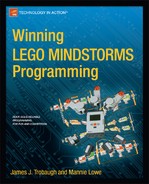Contents
![]() Chapter 1: Meeting the NXT-G Software
Chapter 1: Meeting the NXT-G Software
![]() Chapter 2: Software Design Process
Chapter 2: Software Design Process
![]() Chapter 3: Working with My Blocks
Chapter 3: Working with My Blocks
Managing and Sharing My Blocks
![]() Chapter 4: When Things Go Wrong
Chapter 4: When Things Go Wrong
![]() Chapter 6: Making Smart Decisions
Chapter 6: Making Smart Decisions
Creating a Custom MyPivot Block
Creating a Custom MyTurn Block
![]() Chapter 9: Touching and Bumping
Chapter 9: Touching and Bumping
Touch Sensor As an Indicator of an Object
![]() Chapter 10: Seeing with Ultrasonics
Chapter 10: Seeing with Ultrasonics
Making It Work on the Game Field
![]() Chapter 11: Programming Like a Pro
Chapter 11: Programming Like a Pro
![]() Chapter 13: Programming Pitfalls
Chapter 13: Programming Pitfalls
Use of Stop Block Instead of Stop Motors
Know How to Navigate Your Program
Hardware Tips That Help the Software
Manage Lighting Conditions Around the Light Sensor
Avoid Pointing Ultrasonic Sensors at Each Other
Consolidate Logic into My Blocks
..................Content has been hidden....................
You can't read the all page of ebook, please click here login for view all page.
